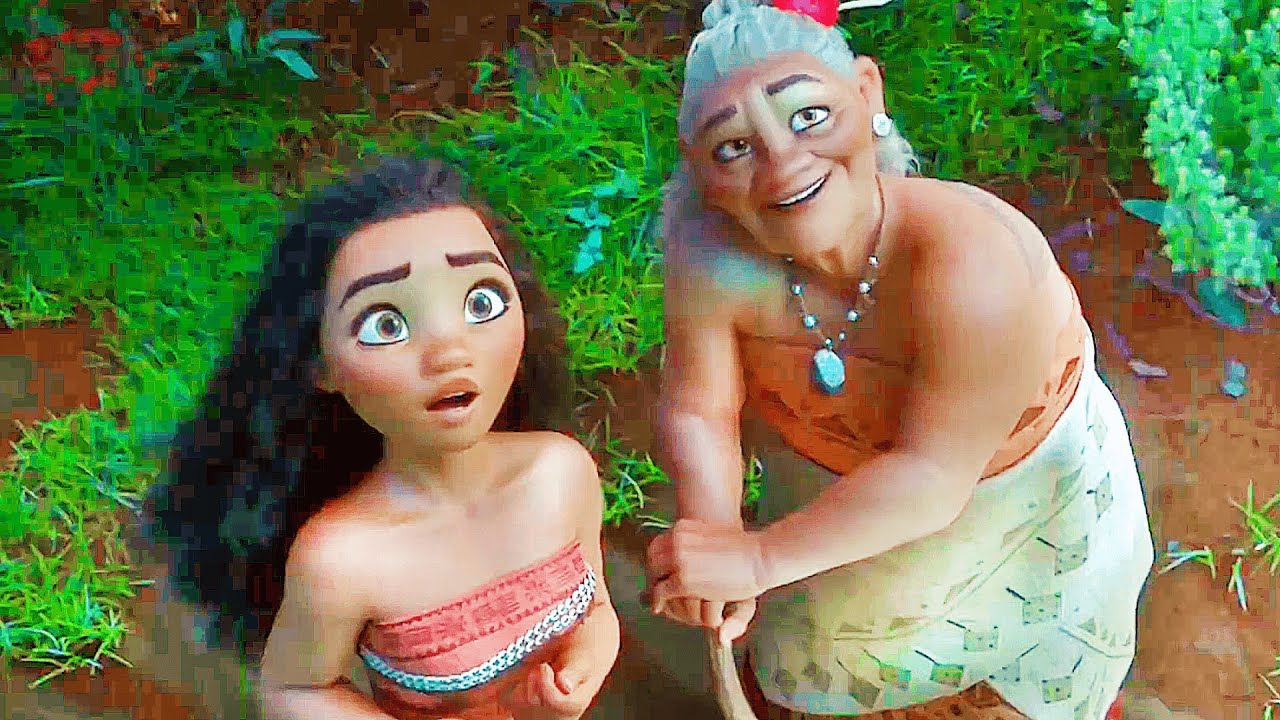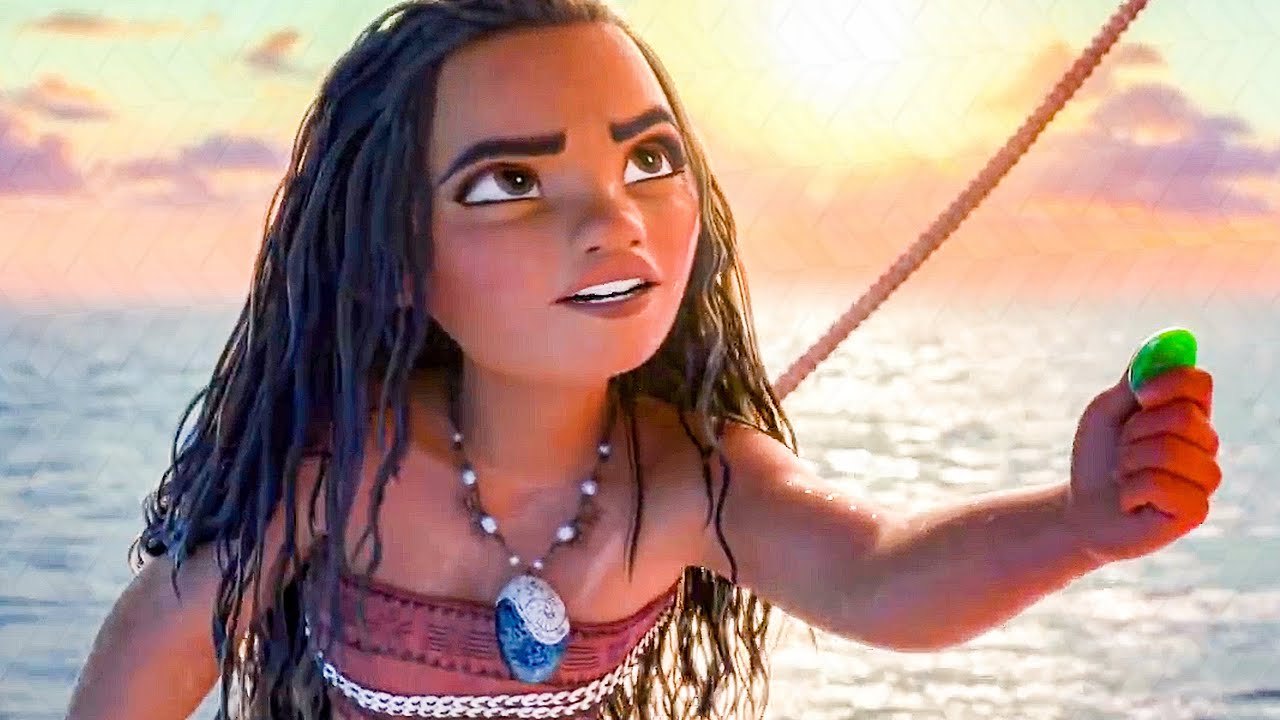Moana (2016)

Plot Overview
Moana begins on the Polynesian island of Motunui, where Moana Waialiki, the daughter of Chief Tui (Temuera Morrison) and Sina (Nicole Scherzinger), is being groomed to lead her people. From a young age, Moana (voiced as a child by Louise Bush) displays an affinity for the ocean, chosen by the sea itself when it gifts her a glowing green heart—a mystical stone tied to the goddess Te Fiti. Her grandmother, Gramma Tala (Rachel House), encourages this connection, sharing legends of Maui (Dwayne Johnson), a demigod who stole Te Fiti’s heart to give humanity the power of creation, only to unleash a curse of darkness that spreads across the islands. Tui, however, forbids Moana from venturing beyond the reef, scarred by a past loss at sea and determined to keep his daughter safe.
As Moana grows into a teenager (now voiced by Auliʻi Cravalho), Motunui faces blight—coconut trees wither, fish vanish—and the island’s resources dwindle. Tala, on her deathbed, urges Moana to heed the ocean’s call, revealing a hidden cave where ancient voyaging canoes lie dormant, proof of Motunui’s wayfinder heritage. Empowered by Tala’s spirit and her heirloom—a necklace holding Te Fiti’s heart—Moana sets sail against her father’s wishes to find Maui and restore the heart, hoping to save her people.
Moana’s journey takes her across the Pacific, where she tracks down Maui on a deserted island after battling coconut-armored Kakamora pirates. Maui, a boastful trickster, initially refuses to help, more interested in reclaiming his magical fish hook—stolen by the lava monster Te Kā after his theft of the heart—than in saving the world. Moana’s persistence and guile force him into the quest, and their partnership evolves from contentious to cooperative as they face trials like retrieving the hook from Tamatoa, a narcissistic giant crab ruling the underworld realm of Lalotai, and navigating treacherous seas to reach Te Fiti.
The climax reveals a twist: Te Kā, a fiery demon blocking their path, is Te Fiti herself, corrupted by the loss of her heart. Moana, realizing this, confronts Te Kā alone after Maui abandons her in a moment of self-doubt. With the ocean’s aid and Maui’s eventual return, Moana restores the heart, transforming Te Kā back into the life-giving goddess. Te Fiti’s restoration heals the ocean, lifting the curse. Moana returns to Motunui a hero, inspiring her people to revive their voyaging traditions as she assumes her role as chief and wayfinder, her bond with the sea stronger than ever.
The screenplay, credited to Jared Bush with contributions from Clements, Musker, and others, balances Polynesian mythology with a universal coming-of-age tale. It’s a tightly woven story at 107 minutes, weaving themes of identity, duty, and environmental stewardship into Moana’s quest without feeling didactic, though some critics note its reliance on familiar “chosen one” tropes.
Since you’ve requested a 2000-word review of Moana (2016), I’ll provide a detailed analysis of this Disney animated film, split into four segments as per your earlier instructions. Directed by Ron Clements and John Musker, with co-direction by Don Hall and Chris Williams, Moana was released on November 23, 2016, and became a beloved entry in Disney’s modern animation canon. As per your request, I’ll avoid labeling the segments with “Part X” or word counts in the titles and focus on four sections: Plot Overview, Character Dynamics and Performances, Direction and Visual Style, and Overall Impact and Reception.
Character Dynamics and Performances
Moana, voiced by Auliʻi Cravalho, is the film’s beating heart, a protagonist who defies the Disney princess mold with her grit and agency. Cravalho, only 14 during recording, brings a raw authenticity—her voice cracks with determination in “How Far I’ll Go,” capturing Moana’s yearning to explore beyond her island’s confines, while softening in tender moments with Tala or her parents. Moana’s growth from a restless dreamer to a confident leader feels organic, her stubbornness and compassion making her relatable rather than archetypal. Cravalho’s performance anchors the film, her Hawaiian roots adding an extra layer of cultural resonance.
Dwayne Johnson’s Maui is a larger-than-life foil, his booming voice and charisma tempered by vulnerability. Johnson leans into Maui’s arrogance—his self-aggrandizing “You’re Welcome” is a showstopper—but also nails the demigod’s insecurity, revealed in quieter scenes where he admits his theft of Te Fiti’s heart stemmed from a need to be loved by humans. His animated tattoos, which act as his conscience and narrate his exploits, add a playful dynamic—Johnson’s ad-libs bring them to life, making Maui a flawed but lovable mentor. The push-pull between Moana and Maui drives much of the film’s humor and heart, their bickering (“I’m not a princess!” “If you wear a dress and have an animal sidekick, you’re a princess!”) evolving into mutual respect.
The supporting cast enriches the story without overstaying their welcome. Rachel House’s Gramma Tala is a mischievous sage, her blend of wisdom and rebellion stealing scenes—House’s warm, crackling delivery gives Tala a spiritual heft, especially in her deathbed farewell. Temuera Morrison and Nicole Scherzinger, as Tui and Sina, ground Moana’s motivations with parental love and restraint—Morrison’s sternness hides a protective grief that cracks beautifully in their reconciliation. Jemaine Clement’s Tamatoa, the underworld crab, is a campy delight, his brief role dripping with menace and vanity as he belts “Shiny” amidst glittering treasure.
The relationships feel lived-in—Moana’s bond with Tala offers emotional grounding, her clashes with Tui reflect generational tension, and her partnership with Maui mirrors a sibling-like rivalry that matures into trust. Even smaller characters, like the ocean itself (a sentient force with a playful personality), or Moana’s pet pig Pua and dimwitted rooster Heihei (voiced by Alan Tudyk’s clucks), add texture without overshadowing the leads. The ensemble’s synergy ensures every interaction serves Moana’s growth, making her triumph feel earned.
Direction and Visual Style
Directors Ron Clements and John Musker, veterans of Disney’s Renaissance (The Little Mermaid, Aladdin), bring a seasoned hand to Moana, blending classic storytelling with modern CGI advancements. The animation, overseen by a team led by Eric Goldberg and Malcon Pierce, is a visual marvel—Polynesian-inspired designs permeate every frame, from the swirling patterns on Moana’s tapa-cloth dress to the intricate carvings on Motunui’s canoes. The ocean steals the show, animated as a living entity with rippling waves and playful tendrils that nudge Moana along her path—its turquoise shimmer and foam-flecked surface are photorealistic yet infused with personality.
The film’s palette bursts with tropical vibrancy—lush greens of Motunui’s forests, fiery oranges of Te Kā’s lava fields, and deep indigo nights studded with stars. Directors use light to reflect Moana’s journey: dawn-lit horizons symbolize hope, shadowed storms mirror her doubts. The underworld of Lalotai, with its bioluminescent glow and monstrous denizens, contrasts sharply with Motunui’s warmth, showcasing the film’s range. Maui’s tattoos, animated in 2D by Goldberg, pop against his 3D form, their playful movements adding narrative depth—each inked tale (like Maui lassoing the sun) underscores his mythic status while hinting at his insecurities.
The pacing is near-flawless, balancing introspection with action. Moana’s training montage with Maui, set to “Where You Are,” builds her skills without dragging, while the climactic confrontation with Te Kā slows to let the emotional weight land—Moana’s realization that Te Kā is Te Fiti, paired with her serene walk through parted seas, is a masterclass in visual storytelling. Songs by Lin-Manuel Miranda, Opetaia Foa’i, and Mark Mancina—particularly “How Far I’ll Go” and “We Know the Way”—are seamlessly integrated, their Polynesian rhythms and soaring melodies propelling the narrative. The score by Mancina enhances the cultural immersion, weaving traditional chants with orchestral swells that evoke the vastness of the Pacific.
Clements and Musker’s direction honors Polynesian culture through meticulous research—consulting with the Oceanic Story Trust ensured authenticity in language, navigation techniques, and mythology. Yet the film never feels like a lecture; its cultural specificity enhances its universal appeal, grounding Moana’s quest in a tangible world while inviting all to sail alongside her.
Overall Impact and Reception
Moana landed as a triumph for Disney, grossing over $690 million worldwide against a $150 million budget, proving the studio’s knack for crafting modern classics. Critically, it’s a darling, with a 95% on Rotten Tomatoes and praise for its animation, music, and cultural reverence—Rolling Stone called it “a tidal wave of dazzling escapism.” It earned Oscar nominations for Best Animated Feature (losing to Zootopia) and Best Original Song for “How Far I’ll Go,” cementing its place in Disney’s pantheon. The soundtrack, propelled by Miranda’s breakout after Hamilton, dominated charts—“How Far I’ll Go” became an anthem for dreamers, earning a Grammy nod.
The film’s impact transcends numbers. Moana’s portrayal as a self-reliant heroine—no love interest, just a quest to save her people—resonated deeply, especially for Pacific Islander audiences who saw their culture celebrated on a global stage. Auliʻi Cravalho’s casting as a Native Hawaiian added authenticity, her voice becoming a symbol of representation. The film’s themes—environmental stewardship, ancestral connection, self-discovery—hit universal chords, while its Polynesian roots offered a fresh lens, inspiring cultural pride and education (schools in Hawaii even used it as a teaching tool).
For 2016 audiences, Moana was a breath of oceanic air—a feminist adventure that didn’t sacrifice heart for empowerment, its vibrant visuals and earworm songs captivating kids and adults alike. Its influence endures: a 2023 live-action remake was announced, with Johnson returning as Maui, and a 2024 sequel, Moana 2, expanded on the story (grossing $760 million by early 2025). Some critiques note its simplification of Polynesian myths or reliance on familiar tropes—the “chosen one” arc, Maui’s redemption—but these are minor against its strengths.
Moana remains a beacon of Disney’s modern era, a film that sails beyond the horizon with courage and aloha. It’s a story of finding your way, not just across the sea but within yourself—a voyage worth taking again and again.











